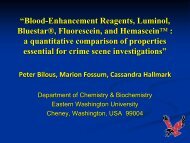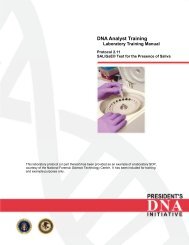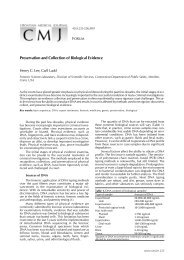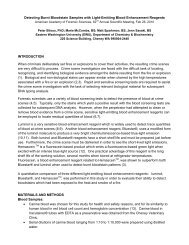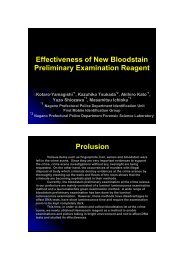Modern methods of collection and preservation of biological
Modern methods of collection and preservation of biological
Modern methods of collection and preservation of biological
Create successful ePaper yourself
Turn your PDF publications into a flip-book with our unique Google optimized e-Paper software.
teeth (if identification is an issue, ensure that mouth x-rays have been taken), <strong>and</strong> a sample <strong>of</strong><br />
compact bone (e.g. femur). The specimens collected should be away from site <strong>of</strong> injury (i.e. if head<br />
injury, do not take sample <strong>of</strong> brain tissue). Immediately freeze specimens, do not place in any<br />
preservative (e.g. formalin).<br />
Collection <strong>of</strong> Urine, Saliva <strong>and</strong> Other Body Fluids follows the same rules as blood <strong>and</strong> blood<br />
stains.<br />
Hair Evidence<br />
If a root sheath is attached, then DNA analysis using PCR technology can say that this hair<br />
came from a certain percentage <strong>of</strong> the population to which the suspect belongs. If there is no root<br />
sheath, then a microscopic analysis can say that the hair has the same characteristics as the suspect's<br />
hair <strong>and</strong> is similar to his or her hair.<br />
Hair found at the scene should be placed in a paper packet <strong>and</strong> then placed in an envelope. If<br />
a microscopic examination is required, then 15-20 representative hairs from the suspect must be<br />
submitted to the lab for comparison. If DNA analysis if going to be used, then a whole blood<br />
sample from the suspect must be submitted to the lab in a "Vacutainer."<br />
3. Transport <strong>and</strong> storrage <strong>of</strong> evidence<br />
When transporting <strong>and</strong> storing evidence that may contain DNA, it is important to keep the<br />
evidence dry <strong>and</strong> at room temperature. Once the evidence has been secured in paper bags or<br />
envelopes, it should be sealed, labeled, <strong>and</strong> transported in a way that ensures proper identification <strong>of</strong><br />
where it was found <strong>and</strong> proper chain <strong>of</strong> custody. Never place evidence that may contain DNA in<br />
plastic bags because plastic bags will retain damaging moisture. Direct sunlight <strong>and</strong> warmer<br />
conditions also may be harmful to DNA, so avoid keeping evidence in places that may get hot, such<br />
as a room or police car without air conditioning. For long-term storage issues, contact your local<br />
laboratory.<br />
Refrigerate liquid blood samples (do not freeze). Air-dry all wet blood <strong>and</strong> other body fluid<br />
stains on evidence items (do not subject to heat). Until submission to the crime laboratory, freeze all<br />
stained items except for any metal or glass items (e.g. knives, bottles). Metal or glass items should<br />
be stored at room temperature <strong>and</strong> submitted to the laboratory as soon as possible.<br />
Evidence from the suspect <strong>and</strong> victim must be h<strong>and</strong>led <strong>and</strong> packaged separately.<br />
4. Issues concerning contamination<br />
Because extremely small samples <strong>of</strong> DNA can be used as evidence, greater attention to<br />
contamination issues is necessary when identifying, collecting, <strong>and</strong> preserving DNA evidence.<br />
DNA evidence can be contaminated when DNA from another source gets mixed with DNA relevant<br />
to the case. This can happen when someone sneezes or coughs over the evidence or touches his/her<br />
mouth, nose, or other part <strong>of</strong> the face <strong>and</strong> then touches the area that may contain the DNA to be<br />
tested. Because PCR replicates or copies DNA in the evidence sample, the introduction <strong>of</strong><br />
contaminants or other unintended DNA to an evidence sample can be problematic. With such<br />
minute samples <strong>of</strong> DNA being copied, extra care must be taken to prevent contamination. If a<br />
sample <strong>of</strong> DNA is submitted for testing, the PCR process will copy whatever DNA is present in the<br />
sample; it cannot distinguish between a suspect's DNA <strong>and</strong> DNA from another source.<br />
Fortunately, an examination <strong>of</strong> DNA b<strong>and</strong> patterns in the laboratory readily reveals the<br />
presence <strong>of</strong> contamination. For example with an STR, one will expect to see a two b<strong>and</strong> pattern. If



